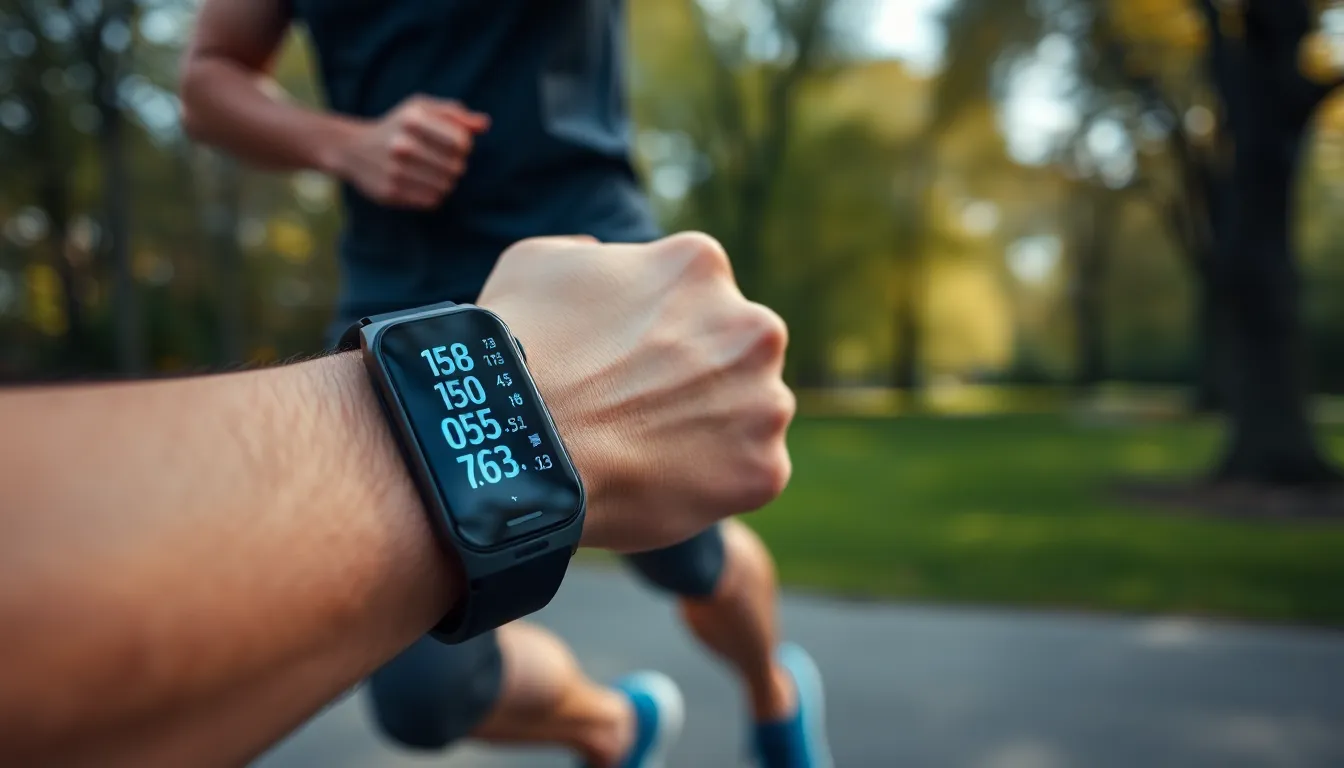In a world where counting steps has become as crucial as counting calories, digital fitness trackers have stepped into the spotlight. These sleek gadgets don’t just sit on your wrist; they whisper sweet nothings about your heart rate, sleep patterns, and even how many times you’ve reached for that bag of chips. Who knew getting fit could come with a side of tech-savvy charm?
Table of Contents
ToggleOverview of Digital Fitness Trackers
Digital fitness trackers gain popularity for their ability to monitor a variety of health metrics. They track activities like step count and distance traveled, providing valuable data for users. Heart rate monitoring adds another layer of insight into cardiovascular health. Sleep pattern analysis helps users understand sleep quality and duration.
Many devices connect to smartphones, enabling users to access detailed reports and insights. Smartphone applications enhance the user experience, allowing for personalized goals and tracking of progress over time. Notably, these trackers often feature reminders for movement, encouraging regular activity throughout the day.
Various types of digital fitness trackers exist, including wristbands, smartwatches, and clip-on devices. Each type offers unique features that cater to different preferences and lifestyles. For example, smartwatches often include comprehensive functionalities beyond fitness tracking, such as messaging and notification features.
User interfaces improve significantly, making it easier for individuals to navigate features. Additional capabilities like GPS tracking provide essential information for outdoor activities, such as running and cycling. Some trackers even offer capabilities to monitor specific workouts, giving feedback on performance and efficiency.
Health insights gathered from these devices empower users to make informed decisions about their fitness routines. Current data suggests that regular usage leads to increased motivation and accountability among users. Ultimately, these devices serve as valuable tools for anyone aiming to improve or maintain their health and fitness levels.
Key Features to Look For

When selecting a digital fitness tracker, consider essential features that enhance functionality and user experience.
Tracking Capabilities
Tracking capabilities are crucial for obtaining accurate fitness data. Look for devices that monitor steps, heart rate, and calories burned. Quality trackers also measure sleep patterns and active minutes. GPS functionality provides real-time tracking for outdoor activities like running and biking. Activities range from swimming to weightlifting, with specific modes designed for different exercises. Comprehensive metrics help users understand their performance and set measurable goals, driving motivation and accountability.
Display and User Interface
Display and user interface significantly affect usability. A clear and vibrant screen enhances readability, especially in sunlight. Touchscreen capabilities allow for intuitive navigation through menus and features. Customizable watch faces enable personalization, reflecting individual styles or preferences. Compatibility with mobile apps is important for accessing detailed reports and setting reminders. Quick access to notifications, such as texts or calls, improves overall functionality, making a tracker more than just a fitness tool.
Popular Digital Fitness Trackers on the Market
Digital fitness trackers offer a range of options catering to different fitness levels and goals. Users can find models suitable for beginners and those designed with advanced features for fitness enthusiasts.
Fitness Trackers for Beginners
Entry-level fitness trackers simplify health monitoring with essential features. Devices in this category typically track steps, calories burned, and basic sleep patterns. Users often appreciate their user-friendly interfaces, making navigation easy. Basic models may include activity reminders and simple mobile app connectivity, allowing for smooth goal-setting. For example, the Fitbit Inspire 2 provides an excellent introduction, featuring a sleek design and intuitive operation.
Advanced Fitness Trackers for Enthusiasts
Advanced fitness trackers come packed with features for serious athletes. Enhanced devices often include GPS functionality, heart rate monitoring, and advanced sleep analysis. Users engaging in specific sports will benefit from tailored modes for activities like cycling or running. The Garmin Forerunner 245 provides in-depth metrics and performance insights, making it popular among endurance athletes. Customization options, such as interchangeable watch faces and app integrations, further enhance the experience for dedicated fitness enthusiasts.
Benefits of Using Digital Fitness Trackers
Digital fitness trackers provide several key advantages that enhance health management. First, they promote consistent physical activity by tracking daily steps and encouraging movement through reminders. Users often notice a boost in motivation when they can visualize their progress.
Secondly, accuracy in health metrics stands out. Many devices measure heart rate and calories burned, allowing for a more comprehensive fitness assessment. This data aids users in tailoring their workouts to achieve specific goals.
In addition, sleep monitoring features contribute significantly to overall wellness. Trackers often analyze sleep quality, providing insights that can improve sleeping patterns. Users gain a better understanding of how rest affects their physical performance.
Another benefit lies in user engagement. Digital fitness trackers often connect seamlessly with smartphones, enabling easy access to detailed reports and trends. Enhanced connectivity encourages proactive engagement in personal health goals.
Moreover, GPS functionality plays a vital role for outdoor enthusiasts. Accurate distance tracking during runs or bike rides complements performance metrics, allowing users to refine their routines effectively.
Certain devices also cater to customization, offering various exercise modes and personalized goals. This versatility meets diverse lifestyle needs, making fitness tracking approachable for everyone.
Data suggests regular tracker usage enhances accountability. The feedback mechanism built into digital fitness trackers helps individuals stay committed to their health journey.
Overall, digital fitness trackers transform health management. They combine technology with personal motivation to create more effective fitness experiences.
Potential Drawbacks to Consider
Digital fitness trackers, despite their many benefits, present certain drawbacks that users should consider. Privacy concerns arise when sensitive health data is collected and stored. Users often need to be cautious about the security of this information, especially when synced with mobile devices or cloud services.
Accuracy might vary significantly among different models. Some trackers provide unreliable readings, especially during high-intensity exercises. This inconsistency can lead to misunderstandings about one’s fitness level or progress.
Battery life is another key concern. Many devices require frequent recharging, which can hinder uninterrupted health monitoring. Users relying on these trackers for continuous activity data may find this aspect frustrating.
Costs also factor into the decision-making process. Premium models come with advanced features, but many entry-level devices offer limited functionality. Evaluating budget against tracking needs is essential when choosing a model.
Dependencies on technology can arise. Some users become overly reliant on fitness trackers for motivation. This reliance might diminish intrinsic motivation, leading to reduced enjoyment in physical activities.
Integration with other apps and services isn’t always seamless. Sometimes, data synchronization issues occur, which can compromise the effectiveness of health tracking. Users may find that they need to manually adjust or input information, undermining the convenience factor.
Regular updates and software improvements are necessary for optimal performance. Trackers without ongoing support may lag in features and accuracy over time. Users should consider the commitment from manufacturers to enhance their devices continuously.
Awareness of these potential drawbacks helps users make informed decisions about integrating fitness trackers into their health routines. Balancing technological benefits with associated risks ensures a more secure and rewarding experience.
Digital fitness trackers are revolutionizing how individuals approach their health and fitness journeys. By seamlessly integrating technology into daily routines, these devices not only monitor vital metrics but also motivate users to stay active. The variety of options available caters to different lifestyles and fitness levels, ensuring there’s a suitable tracker for everyone.
While they offer numerous benefits, users should remain aware of potential drawbacks such as privacy concerns and accuracy issues. Balancing the advantages of these trackers with their limitations can lead to a more fulfilling fitness experience. As technology continues to evolve, digital fitness trackers will likely become even more integral to personal health management, encouraging a healthier and more active society.



